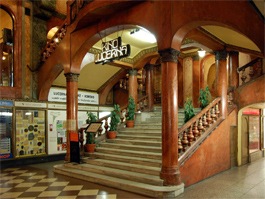
Invalidovna and Lucerna have become national cultural monuments
 |
During the comment procedure, several sacred buildings were removed from the list of structures that would enjoy the highest state protection. The original list of the Ministry of Culture consisted of 18 items, including a collection of small structures in the landscape - chapels, wayside shrines, and peace crosses representatively selected from the South Bohemian, South Moravian, and Vysočina regions. The proposal also included a pilgrimage church with a Passion path in Římov from the second half of the 17th century, which is considered by experts to be an exceptional example of baroque architecture associated with pilgrimage tradition and simultaneously contributing to the image of the South Bohemian baroque landscape. The reason for the removal of these collections is not clear from the material presented to the government.
The government declares NKP, the last collection being nine objects in 2015, which included movable monuments such as the Vyšebrodský cycle, the Madonna from Veveří, the Oldboleslav palladium, and Gothic paintings.
NKP constitutes the most significant part of the country's cultural wealth, and it is subject to stricter protection than cultural monuments, of which there are also many more. Similar to cultural monuments, the export and sale of NKP are regulated by law. Including the nine mentioned artifacts, the NKP collection now consists of 306 items.
The first group of monuments approved today consists of structures from the first half of the 20th century, documenting the stylistic plurality of architectural production during this period. All are works of prominent architects. Among them is a secondary school in Mladá Boleslav, an example of constructivism, expressionism, and art deco, built between 1922 and 1926 according to the design of architect Jiří Kroha.
The city museum, formerly the Wenke department store in Jaroměř, is the work of Josef Gočár, while the City Theater in Ústí nad Orlicí was built by Kamil Roškot in the style of organic functionalism. Today's Community House in Opava, designed by Leopold Bauer, represents the transition from Art Nouveau and modernity to interwar neoclassicism and historicism.
The second group consists of monuments that are either proposed repeatedly or exhibit values that have only recently been sufficiently appreciated. This includes the remains of the Romanesque castle in Cheb, the Blatná water canal, the Ďáblice Cemetery in Prague with the graves of political prisoners and members of the second and third resistance, or the monastery in Louka near Znojmo, one of the most valuable examples of late baroque art in Moravia.
The Prague Invalidovna is a monumental baroque work designed by Kilián Ignác Dietzenhofer. After years of being unused, the state unsuccessfully attempted to sell it last year, and the National Heritage Institute has expressed interest in its management. The Lucerna Palace in Prague, associated with the Havl family, bears the features of waning Art Nouveau and emerging modernism, is one of the first reinforced concrete structures in Prague, and is a well-known cultural center.
The English translation is powered by AI tool. Switch to Czech to view the original text source.
0 comments
add comment
Related articles
6
29.09.2020 | The National Heritage Institute presented the project for the restoration of the Prague Invalidovna
0
12.06.2018 | The Lucerna Palace in Prague will have a new facade
0
14.05.2018 | The monument preservers will take over the Invalidovna, they want to invest a billion in it
0
14.05.2018 | In the Invalidovna, the photographer Sudek created, and Amadeus was filmed here as well
0
13.06.2017 | Conservationists still want the Invalidovna, they published the budget for its renovation
0
21.02.2017 | As a monument, Roškota Theater could receive grants
0
17.02.2017 | MKČR proposes the Invalidovna or Lucerna as a national cultural monument
0
24.11.2016 | National cultural monuments could include another 18 buildings
0
19.08.2016 | Heritage preservationists submitted a request for the Prague Invalidovna
1
08.08.2016 | Invalidovna could remain in the hands of the state, the NPÚ is interested in it
0
01.06.2016 | The owners want to register the Lantern as a national cultural monument
2
20.03.2011 | Václav Havel built in Prague a Secession gem of European format












